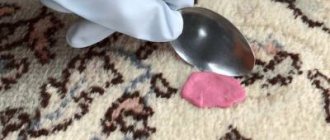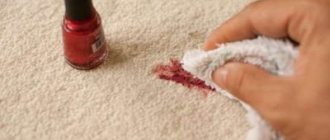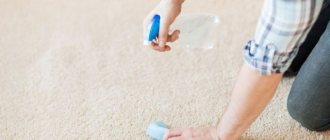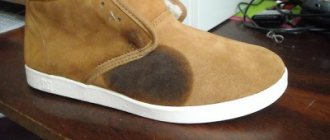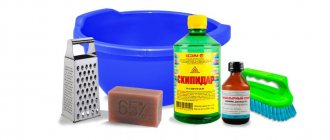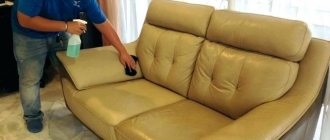There is, perhaps, no family in which iodine is not used: to disinfect a wound, treat a child’s skinned knees, make an iodine mesh, cauterize ripening barley, and much more.
Often you have to act as quickly as possible. You need to unscrew the cap, pick up the tight-fitting stopper, tilt the bottle and insert a cotton swab into it.
However, it is not always possible to protect your fingers, table and floor covering from stains. We will tell you how and how to remove iodine from a carpet in this article.
How to remove a fresh iodine stain?
It is easier to remove an iodine stain on a carpet at home while it is fresh.
Most often, the first thing iodine remains on the fingers is when opening the bottle. A dishwashing sponge will come to the rescue. You need to lather the hard, abrasive side of the sponge well and rub your fingers with it, periodically rinsing them under running warm water. Usually, it takes 3-5 minutes to wipe a stain from the skin.
Advice! It is better to wash smooth surfaces (leather sofa, table) with a damp sponge. Stains on porous surfaces (wooden furniture, parquet) or fabric coverings (upholstered furniture) should be blotted, either with a dry soft cloth or cotton pads, changing them as they become dirty.
It is recommended to blot up iodine solution spilled on the carpet with absorbent wipes or paper towels. A variety of options can be used as a cleaning mixture, which will be discussed below.
Have you ever cleaned your carpet from iodine stains?
Not really
Causes of carpet contamination
If you do not remove a stain on the carpet immediately, it will be more difficult to do so later.
Any carpet inevitably gets dirty, because people constantly walk on it, spill liquids, and drop food.
The most common types of pollution:
- dirt and sand;
- dust;
- chemicals or medications;
- fats and technical oils;
- food and drinks;
- hair and animal fur;
- urine from children and pets;
- paint and resin.
You can scrub off complex stains only after determining the composition of the stains. The main thing is to choose the right detergent.
To effectively remove specific contaminants, special mechanical and chemical treatment is required.
General recommendations
Iodine stains are difficult to remove. To remove iodine from carpet, it is important to follow these general guidelines:
- act as quickly as possible;
- When removing stains, move from the edges to the center;
- start rubbing the stain, if possible, from the wrong side;
- Since a fresh stain can be imprinted on everything it comes into contact with, you should not place anything on it. If it drips onto fabric (clothing, tablecloth, etc.), you should not fold it;
- Iodine disappears most quickly when exposed to sunlight. If possible, you need to create conditions for sunlight to reach the spot.
How to remove marks from coating at home?
Careless use of iodine may leave a stain on the floor. If liquid has spilled where it is not noticeable, you don’t have to do anything. This is especially true for smooth surfaces: linoleum, laminate, ceramic tiles.
Attention! Iodine is a volatile substance and will evaporate on its own over time. But if the stain is in the most visible place, you want to get rid of it as soon as possible.
Fortunately, there are dozens of ways to clean spilled iodine from your flooring. In any home there will always be more than one remedy.
Soda and vinegar
This method is suitable even for stale stains. Baking soda and vinegar are suitable for all surfaces except nylon. Sprinkle the stain with baking soda and rub lightly. Then pour 9% or 7% table vinegar over the stain. A chemical reaction will occur and the solution will hiss.
After 3-4 hours, the stain should be washed with soapy water or detergent. After drying, the area of contamination should be vacuumed. If the stain remains, it is recommended to repeat the procedure.
You can also use baking soda and vinegar when cleaning your microwave.
Acetone
Using acetone (or nail polish remover) you can remove iodine even from long-pile carpeting. True, there is one “but”: acetone cannot be used to remove traces of iodine from delicate fabrics. Therefore, this product must first be tested on an inconspicuous area of the carpet.
If the pile is not damaged or faded, then acetone can be used over the entire area of contamination. It is necessary to sweep the sponge over the entire area of contamination.
Important! When working with acetone, it is important to be careful: wear personal protective equipment (mask, gloves) and open the window.
Hydrogen peroxide
Hydrogen peroxide is only suitable for light-colored rugs. The product is poured from the bottle directly onto the stain. If the carpet has a long pile, it will be more convenient to apply the product to the contaminated area using a sponge or cotton swab.
After treating the iodine stain, you need to wait a few minutes and wash off the composition with soap and water. If the first treatment does not help, the procedure can be repeated. Finally, wash the stain with soapy water.
Sodium thiosulfate
The drug "Sodium thiosulfate" helps not only with intoxication and allergies. It works well on iodine stains on the carpet. This product is safe to use and non-toxic. Here are the cleaning instructions:
- fill a glass with cold water (half a glass is enough for a small stain);
- add 1 tsp to water. sodium thiosulfate and stir;
- Apply the resulting solution to a sponge or cloth;
- scrub the stain, carefully moving from the edges to the center.
Advice! If necessary, the solution can be reused until the result is achieved. Then wipe the contaminated area with a damp piece of cloth to completely remove the solution.
Alcohol
Pharmaceutical alcohol is a classic means for cleaning various surfaces, including carpets. The advantage of this product is that it copes even with bright spots. There are 2 options for preparing the solution:
- 1 tsp The drug must be diluted in 400 ml of water. The resulting solvent should be thoroughly rubbed into the carpet, wait half an hour, rinse with water and dry;
- Pharmaceutical alcohol in its pure form must be applied to the stain, rub the stain from the edges to the center, and after 15 minutes rinse thoroughly with water.
Potato starch
To remove iodine from carpet, you must first blot the stain with a paper napkin and moisten the area of contamination with water. Pour starch onto the moistened stain and rub in the resulting paste using a sponge or brush. The treated area of the carpet is left for 20 minutes. During this time, starch enters into a chemical reaction with iodine.
As soon as the mixture turns brown, it must be removed from the surface using a sponge and cold water. The procedure may need to be repeated several times until the stain is as light as possible. At the end of the procedure, you need to wipe the problem area of the coating with a cleaning solution.
On a note! To prepare the solution, dissolve 1 tablespoon of grated soap (preferably laundry soap) in 1 liter of warm water. After cleaning, the carpet can be dried with paper towels and then with a hairdryer or fan.
Mineral water
To remove iodine stains from carpet at home, you can use carbonated mineral water. Gas bubbles in water serve as activators for the separation of iodine from the carpet pile.
The stain is filled with carbonated mineral water. This will help the iodine components separate from the carpeting. The most convenient way to apply mineral water to the contaminated area of the carpet is with a spray bottle. After spraying the liquid, leave it for a couple of minutes, then wipe the problem area with a piece of damp cloth.
If the stain remains, the procedure must be repeated 1-2 more times. The area of contamination should be thoroughly blotted with a paper towel or dried with a fan.
IMPORTANT! Do not use a hot air dryer for drying: high temperatures can destroy the carpet pile.
Soda
You can use baking soda to remove iodine stains from carpets. Apply 2 teaspoons of baking soda to the iodine stain. Apply a few drops of water over the mixture until a paste forms.
After 3-5 minutes, you should begin to clean the stained area with a stiff brush, trying not to go beyond the boundaries of the stain, moving from the edges to the center. The darkened salt mixture must be removed with a napkin. If necessary, the procedure can be repeated.
Salt
Salt has proven itself to be effective in removing iodine stains from rugs. Quickly spreading between the villi, it prevents iodine from being absorbed into the carpet. The iodine stain should be sprinkled with salt so that it completely covers the area of contamination.
If the carpet has a high pile, you need to arm yourself with gloves and sprinkle salt between the piles. After 20-30 minutes, vacuum the carpet. If the stain is not completely cleaned, cleaning can be repeated.
"Mole"
The Mole pipe stain remover can also be used to remove stains from the carpet. Mix 0.5 tsp of liquid in 200 ml of water.
The area of contamination should be vacuumed. Before working with Krot, be sure to wear protective rubber gloves. The cleaning solution is applied using a pipette in a few targeted drops. After 5 minutes the mark should disappear. After this, quickly rinse the flooring with plenty of water.
Advice! To avoid mold, dry thoroughly. Recommendation: first test the aggressive composition on an inconspicuous area or on the underside of the carpet - make sure that the product will not spoil the appearance of the product.
Lemon juice
If iodine has been spilled on a light-colored carpet with long or short pile, lemon juice will be an effective assistant in cleaning the stain. It has whitening properties, and a fresh lemon smell will be a pleasant bonus. It is necessary to squeeze the juice into a container (for example, a plastic glass), dip a piece of cotton wool into it and gently rub the stain, starting from the edges.
The stain will lighten in just a few seconds. After 30 minutes, the chemical reaction between the acid of lemon juice and iodine will be completely completed, all that remains is to rinse the contaminated area with water and dry it.
Moisten the stained area with freshly squeezed lemon juice or regular citric acid diluted in water. Leave the stained carpet for a short time to allow the substance to eat away the iodine. Wash off any remaining dirt with cold water, without detergents.
ATTENTION! Lemon juice can only be used for plain light-colored carpets or coverings with a light pattern. A light stain from lemon juice may remain on a dark-colored coating.
Milk
Using milk you can remove old iodine stains. Milk should be poured onto the stain and left for 10-15 minutes. After this, you need to wash the dirty area of the carpet with soap or powder.
Ascorbic acid
Ascorbic acid in any form is good at removing iodine from carpet surfaces. Liquid acid (sold in ampoules) should be applied to the surface and left for 10-15 minutes. The exact exposure is determined by eye until the spot disappears. After this, the contaminated area should be rinsed with clean water. You can also use vitamin C in tablets.
IMPORTANT! Vitamin C should be without any additives. 1-2 tablets should be dissolved in half a glass of water. The cleaning mechanism is the same as when using liquid ascorbic acid. At the end of the procedure, the problem area should be washed or wiped with a damp cloth or sponge.
Salted kefir
Half a glass of kefir should be mixed with one teaspoon of salt. IMPORTANT! Kefir should not be cold (so that the salt dissolves better) and have a low fat content (so that the stain dissolves better). The mixture should stand for 5 - 10 minutes until the salt is completely dissolved.
The stain should be carefully treated around the edges with liquid detergent or dish soap. This is necessary so that the stain does not spread out in size. Using the soft side of the sponge, apply salted kefir to the stain and soak it well. The mixture should be left on the carpet for 10-15 minutes, then washed off with water and detergent.
Micellar water
To remove iodine stains from carpet, you can use any brand of micellar water.
IMPORTANT! This remedy only works on a fresh stain; it may not cope with an old iodine stain.
Water should be poured onto the stain generously enough so that the stained area is well saturated. After a couple of minutes, you should begin to gently scrub the stain using a medium-hard brush. After this, you need to take alcohol or cologne, apply a few drops to the stain and rub again. Residues of the cleaning product must be removed with water and carpet cleaner.
Hot pickle
Before using this method, you should make sure that the carpet will not be damaged by high temperatures. To do this, you must first test the effect of the brine on an inconspicuous area of the carpet (for example, on the underside). You need to add salt to boiling water at the rate of one teaspoon per half cup of boiling water. The salt should completely dissolve.
Hot brine should be poured over the stain until it cools down. Care should be taken when using hot solution.
Prohibitions when deleting
- When working with acetone and other aggressive solutions, personal protective equipment (mask, gloves) should not be neglected.
- For dark and colored carpets, do not use bleach, lemon juice, hydrogen peroxide and kefir.
- When experimenting with cleaning solutions, do not mix vinegar and soda with chlorine, chlorinating agents and bleaches. Combining them, especially in a closed container, can lead to the formation of harmful gases and even cause an explosion.
When should you go to dry cleaning?
If you decide to save on dry cleaning, you may lose your carpet. Therefore, sometimes it is worth realistically assessing your strengths and leaving the carpet cleaning to professionals. In addition to removing the stain, the owner of the carpet will receive an almost new-looking, fresh carpet product without stains.
It is better to immediately contact professional cleaners if:
- the pollution has penetrated so deeply that it is impossible to reach it;
- old stain;
- the family has small children, pets, and allergy sufferers, which limits the possibility of experimenting with cleaning products (vinegar, acetone, etc.);
- after trying to clean the stain yourself, streaks remained on it;
- The carpet contains silk, viscose, etc.
Where to inexpensively order removal of iodine marks
To avoid damaging the carpet when trying to wash it, it is better to entrust the cleaning to professionals. Such services are provided by specialists from the Zvezda factory. For more than 10 years we have been engaged in professional cleaning, removing various contaminants from surfaces such as:
We provide our clients with complete dry cleaning of carpets from iodine stains using properly selected reagents. This means that the product remains beautiful, clean, and bright. Additionally, after our work, the rugs lift the pile and emit a light aroma of freshness. We work according to the following principles:
How to remove a dried stain?
It happens that there is simply no time or opportunity to immediately react to spilled iodine. A stale stain can also be removed, but the older it is, the more aggressive means must be used to remove it.
IMPORTANT! Be careful to test cleaning solutions on inconspicuous areas of the carpet (such as the underside).
To evaluate how a particular product acts on the carpet material, 15 minutes is enough. If the carpet does not show a negative reaction, this product can be used to clean the carpet.
There are 2 products available for cleaning old iodine stains:
- Acetone. Carefully apply acetone to the iodine solution using a cotton pad or swab. Within 2-3 minutes a chemical reaction will occur, the result of which should be the clarification of iodine. At the end of the procedure, you need to thoroughly rinse the carpet fibers and ventilate the room;
- Ammonia. This product has an unpleasant odor, but has proven itself in removing stains, including carpets. One teaspoon of ammonia should be diluted in a glass of warm water and soak the carpet pile with it. After 15-20 minutes, the remaining product should be washed off with soapy water.
You will find simple step-by-step instructions on how to remove stains from carpet at home in this article.
Recommendations for removing iodine from carpet
- . Before using one method or another, try experimenting on an inconspicuous piece of carpet to make sure nothing happens to the carpet.
- .Use your chosen option first and then rinse with water. And so on in turn, depending on how many times you work.
- .If the stain is not completely removed from a light-colored material, then ventilate the room; it will disappear thanks to the air.
- .Always use disposable gloves to protect your hands.
- . To make the water trail dry faster, try turning on the fan. Do not take an electric hair dryer under any circumstances!
- . Always remove chemical residues after cleaning.
- Lastly, always try to tackle iodine stains while they are fresh. It’s quite difficult to “say goodbye” to the old ones.
We hope that the products will definitely help, and we wish you only clean carpets in your home.
How to remove brightly colored stains?
Iodine antiseptic quickly absorbs into carpet fibers and is quite difficult to clean. Alcohol, regular or technical, will help remove stains from brightly colored iodine. Apply alcohol to the iodine stain and leave for 10-15 minutes. After this, the area of contamination should be rinsed well with water.
Another way to clean bright stains from carpet is with a soap solution and starch. First you need to blot the stain with a paper napkin to absorb excess iodine. Then a paste of starch and water should be applied to the contaminated area of the carpet. After 15 minutes, a chemical reaction of the cleaning solution with iodine should occur and the stains should be destroyed.
Advice! If the stain is not completely removed, you can try using a soap solution. To do this, you will need to whittle down laundry soap (one tablespoon) and mix it thoroughly in a liter of water.
The contaminated area of the carpet must be cleaned from the front and back sides using a medium-hard brush. The resulting soap foam must be removed with a rag, rinse the pile with water and dry the carpet with a fan or hairdryer.
You will find 14 reliable ways to clean a carpet at home quickly and effectively in this article.
Do you use folk remedies to clean your carpet?
Not really
What are the dangers of self-purification of iodine?
If you don’t want to take your carpet to the dry cleaner (you don’t have time, you don’t know who to trust), then it is important to remember that treating stains yourself can lead to the following consequences:
- Damage to the thread structure when trying to wash the product. This is especially true for those carpets that cannot be wet cleaned (silk, wool, leather, jute, etc.). From such an impact the palace loses its shape.
- Burnout of colors. When making different types of rugs, factories (craftsmen) use certain types of dyes, which can form an unexpected reaction with the cleaning agent used. As a result, the iodine will leave, but the place of contamination will still leave its faded mark.
- Lack of reaction, stain spreading across the coating. This is the best result of home cleaning from iodine. But the fiber or brightness of the colors will not be damaged when trying to wash the coating.
- Poor drying of long-pile rugs and, as a result, mold growth inside the woven structure. The fungus tends to provoke allergic reactions. Especially in children.
- Shrinkage of the carpet and damage to the fiber structure when diligently drying the product with a hairdryer. This cannot be done at all. Parts of the product that have been soaked in water and then dried with a hairdryer tend to shrink significantly. This is especially true for thin lint-free rugs.
Useful tips
- Iodine stains need to be cleaned from the edges to the center so that they do not spread out in size.
- When drying a cleaned carpet, it can be used as a fan. so is the hairdryer. But when using a hair dryer, you need to avoid hot air - this can ruin the carpet. If time permits, the carpet can be dried naturally, in the sun (for example, on the balcony).
- The longer you wait to remove stains, the more labor-intensive the process will be. It is advisable to remove spilled iodine stains within the first three days.
- If the carpeting is expensive or the material contains silk, wool and other delicate fabrics (for example, an oriental rug), it makes sense to contact a dry cleaner. Cleaning company specialists, as a rule, understand the types of stains and guarantee results.
- Cleaning solutions made from chemical and natural products must be removed from the carpet using a brush, sponge (with the soft side so as not to damage the pile), or microfiber cloths.
- Before applying the cleaning agent, it makes sense to blot the stain with a cotton pad or swab. Its color will tell you whether there is still iodine left on the surface of the carpet. The procedure can be repeated several times until the cotton pad or swab is clean.
- It is important to dry the carpet thoroughly after cleaning. Otherwise, an unpleasant odor or even mold and pathogens may appear.
- To avoid damaging the carpet, the cleaner should first be applied to an inconspicuous area of the carpet (for example, on the underside, on the lining, or near the seams).
- If iodine stains cannot be cleaned, there is no need to worry: over time they will lighten and fade on their own, especially if the carpet is located in such a way that the sun's rays fall on it.
- If an aggressive agent is chosen as a cleaning agent, stain removal should begin with a weak solution, gradually increasing the concentration.
- The last step of every cleaning should be to wash the stain with water.
- It is more convenient to wash up the stain not directly on the floor (at the risk of ruining or wetting the floor), but by placing a wooden plank or other sealant under the contaminated area of the carpet.
- It should be remembered that when using any stain remover (chemical or natural), the carpet will become thinner, so you should not use more than the amount indicated for a particular cleaning method.
- Before you begin removing iodine stains from the carpet, you need to clean it of dust and debris.
What not to clean the carpet
| Prohibited substance | Description |
| Snow | Wool carpets, especially old ones, do not tolerate cold temperatures well. The fibers simply disintegrate. Snow cannot yet be called environmentally friendly - in cities it often falls with impurities of various chemicals. |
| Much water | It harms carpets with adhesive backing - they become wet and deformed. And a hand-painted product runs the risk of fading. |
| Cleaning products not specifically formulated for carpets | Dishwashing detergents are allowed to be used - they are relatively safe for health. But you should avoid washing powders and household chemicals - they are poorly washed out of the carpet and lead to irritation of the mucous membranes and allergies. |
| Hard brushes | Metal brushes and hard-pile products pull threads out of carpets and deform the fabric. |
| Car wash and other devices that supply water under pressure | Lead to deformation of carpets. The pile unwinds, and “bald patches” and protruding threads appear. |


